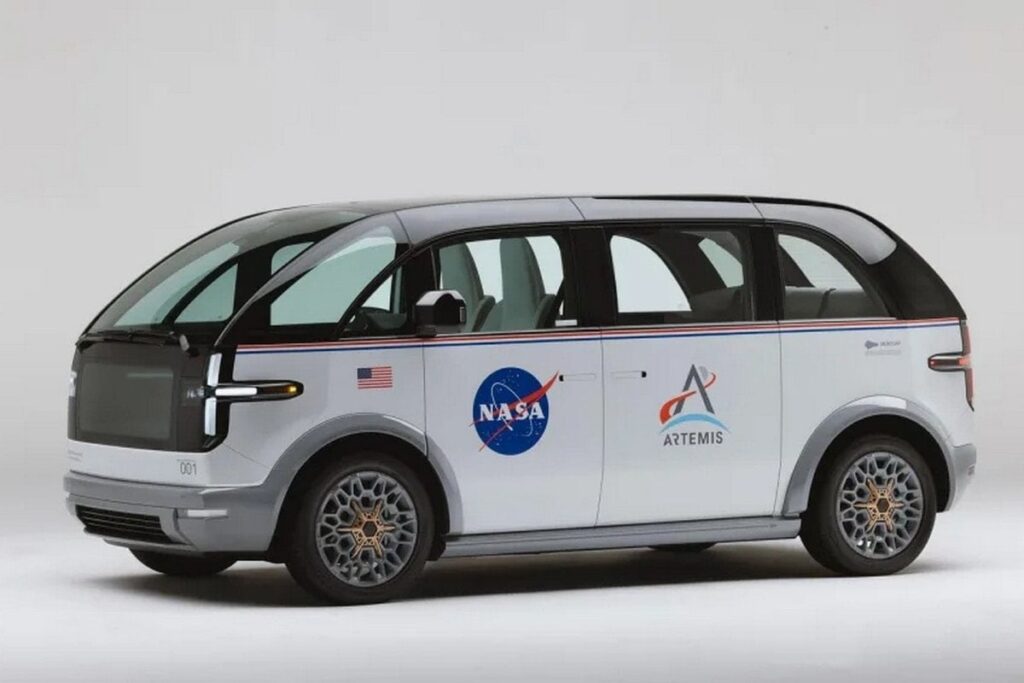
Audience
- Sentiment: Positive
- Political Group: Progressives
- Age Group: 18-34
- Gender: Both
Overview
- NASA continues using electric vans for Artemis missions despite Canoo’s bankruptcy.
- The shift to electric vehicles emphasizes sustainability and environmental responsibility.
- NASA is proactive in finding solutions to maintain the electric vans for future operations.
NASA’s Bold Ride into the Future: Continuing with Electric Vans Despite Manufacturer Bankruptcy
When we think of NASA, images of rockets blasting off into space or astronauts floating in zero gravity tend to come to mind. But did you know that even the vehicles that transport these astronauts to the launchpad are part of the cutting-edge technology that NASA is embracing? That’s right! NASA plans to continue using a fleet of electric vans, worth an astonishing $150,000 each, to transport astronauts for its Artemis missions, despite some pretty big news about the company that made them. Let’s dive deeper into why this is significant and what it means for the future.
What Happened with Canoo?
Canoo is a company that had big dreams of changing the automotive industry with innovative electric vehicles, including those high-tech vans designed specifically for NASA. Unfortunately, in January 2023, the company filed for Chapter 7 bankruptcy. This means that Canoo is liquidating its assets, essentially deciding to shut down its operations completely, which is a tough but necessary decision for the company when it could no longer sustain itself financially. Despite the ambitious plans for electric vans and a cleaner future, Canoo struggled to attract investors and keep their dreams afloat.
Imagine being part of a team that works tirelessly on developing something transformative, only to see it unravel. It’s like working on a group project for school where you put in all the effort, but the project ends up falling apart at the last minute. That’s pretty much what happened to Canoo.
Why Does This Matter to NASA?
So, you might wonder—what does Canoo’s bankruptcy have to do with NASA and its missions? Well, first, let’s understand the context. The Artemis missions are NASA’s ambitious plan to return humans to the Moon and eventually send astronauts to Mars. It’s considered a giant leap for humanity and a significant step in space exploration. The electric vans were essential for transporting astronauts from their crew quarters to the launchpad, which is a pivotal part of the launch process.
Even though Canoo is no longer in business, the electric vans that are currently in use are still operational. NASA confirmed that they are suited for training and mission preparations, which means they are ready and safe for astronauts to use. While it’s easy to panic over the uncertainty of their maintenance and support in the future, this situation offers an exciting glimpse into the evolving landscape of transportation technologies.
Electric Vehicles: The Future is Now!
The use of electric vans highlights an important trend: the increasing reliance on electric vehicles (EVs) to reduce carbon footprints and promote sustainability. For years now, people have been aware of the environmental impact of traditional gas-powered vehicles, which contribute significantly to air pollution and greenhouse gas emissions. NASA’s decision to utilize electric vans is an essential move toward cleaner energy solutions.
But why is this shift towards electric vehicles so important? Here are a few key reasons:
- Environmental Impact: Electric vehicles produce zero tailpipe emissions, which is a huge deal for air quality. When you think about the world we live in and the challenges posed by climate change, every small step toward sustainable energy counts.
- Cost-Efficiency: While the upfront cost of electric vehicles can be higher, they are often cheaper to maintain over time. They don’t require oil changes, and electricity can be cheaper than gas, especially as renewable energy sources expand.
- Innovation and Technology: The push for electric vehicles drives innovation in battery technology, charging infrastructure, and even renewable energy integration. By investing in this technology, organizations like NASA are not just improving their operations; they are setting an example for industries worldwide.
NASA’s Commitment to the Future
Although Canoo’s bankruptcy presents challenges regarding the electric van’s future maintenance, NASA is proactive in seeking solutions. They are engaged in discussions to find ways to support and sustain these vehicles. The agency understands the importance of these vans in the greater context of the Artemis missions and the statement they make about committing to sustainable transportation and technology.
NASA’s move to continue using these electric vans is a clear signal that they are not just focused on space exploration, but also on how they can embrace technological advancements that reflect the values of stewardship of our planet.
Looking to the Stars and Grounded in Reality
The electric vans symbolize the merging of space-age technology with everyday life. They may not travel the cosmos, but they are crucial elements in making sure the next generation of space travelers gets to the launchpad safely and efficiently. It also brings a sense of reassurance that even in challenging times, innovation can pave the way forward.
Imagine the astronauts as they prepare for their missions, stepping into a high-tech electric van, knowing that this vehicle represents not just a new way of getting to the launchpad, but also a commitment to a more sustainable future. It’s a true reflection of human creativity and resilience.
Bridging the Gap
One question that often comes up is, “How can we ensure that technology like electric vehicles keeps progressing, especially when companies face challenges like bankruptcies?” This question leads to various thoughts about education, investment, and public interest in sustainable technologies.
Encouraging young people (like you!) to study fields related to science, technology, engineering, and mathematics (STEM) can create a future workforce that is equipped to solve such challenges. When students get enthusiastic about these subjects, it sparks innovation and entrepreneurial spirit, which are precisely what the world needs.
Conclusion: A Journey Ahead
NASA’s electric vans carry a lot more than astronauts; they carry the hopes of a greener future and the promise of continued innovation. As we watch the developments in both space exploration and the automotive industry, it’s important to remain optimistic. The challenges faced by Canoo might be setbacks, but they also open the door to new ideas and alternatives.
So, let’s wrap this up with a thought-provoking question: What role do you think we all can play in supporting innovative technologies, like electric vans, in our daily lives? Do you believe that the future will be electric, not just for NASA but for everyone? Share your thoughts in the comments below!






